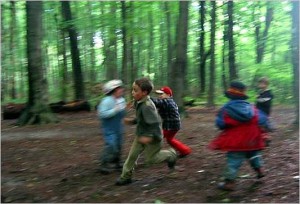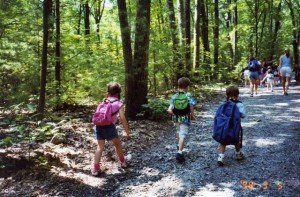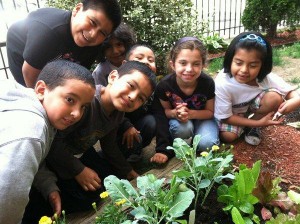Hi Everyone,
First of all, hats off to the Outdoor Education Team Teach last week. What a great job at taking our learning outside and having lots of fun getting active in the fresh air and sunshine!
I have been thinking a lot about outdoor activity lately. I have my practicum at an elementary school in West Vancouver and have been assigned to the kindergarten class. As the “little ones” at the school they have an assigned playground where there are several swings and climbing structures and such traditional items. However, I have noticed that every time they are excused for recess and lunch they run off to the area of the playground that borders a natural forest. It has lots of trees and a more rugged terrain and the students always spend their free play time there collecting rocks and swinging from tree branches. No one seems to be interested in playing in the structured playground area.
It led me to think about how much kids just love to be outside! Rain or shine they want to naturally explore and engage with others and the environment. So, I have been thinking about others ways that I could engage the kindergarten class in outdoor learning. What first came to mind was group mini hikes, as West Vancouver has lots of beautiful easy nearby trails, that would be good for younger children. There are also beaches and small lakes and waterfalls too. What a great way to also incorporate some learning about ecosystems and sustainability. But, while these ideas seem fun I am still unsure how I can organize transport and extra adult supervision and what types of legal formalities I am required to complete. As this task seems a little daunting, I will require clarification from my school advisor. Perhaps, these types of hurdles are what inhibit some teachers from planning outdoor education excursions?
Therefore, I thought I would start small. We have a beautiful field at my practicum school where I thought we could do some fun activities, but also perhaps some lessons. What about literacy outdoors? Reading and drawing outside incorporated into some type of physical activity that pertains to the literacy might work. For example, reading a story about the environment and then finding leaves and flowers from a scavenger hunt around the field that the students can then draw or paste into scrapbooks. I also thought that in an effort to support the inquiry learner a community garden outside the classroom might be a fun project which marries physical components with lesson plan initiatives. Of course, as the weather worsens with the arrival of winter this might become a little tricker, but I think more simplistic outdoor concepts might be a good place to start.
I look forward to working towards these outdoor initiatives and engaging my students in finding out what they would like to do and what they would like to learn. I think there are many ways in which we can incorporate outdoor learning into our classroom teachings and I hope to do lots of it soon!




Hi Jen!
I really liked your post. I so enjoyed the scavenger hunt class last Wednesday as well, and I was thinking similar things during my practicum on Thursday too. I definitely agree with your comment about the planning of outdoor excursions being daunting and it made me wonder about the involvement of parents in this situation. At school students are required to complete 30 minutes of daily physical activity (DPA) per day at the bare minimum. In addition to this teachers may also want to plan fun and active outdoor activities, such as hiking like you mentioned in your post. If a parent does not value physical education in the same way the teacher does, would they object to their child being included in something like a hike? It seems strange to me, but I’m guessing this has happened before and I would be interested in knowing how the teacher handled it. I value physical education and will definitely be encouraging it in my own teaching practice, it will be helpful to know how to approach any conflicts with parents in this sense.
Your post also made me think about the students in my practicum school. Meadowridge enforces the policy of every recess and lunch being spent outdoors, no matter what the weather is. I think this is one of my favourite things I’ve learned about the school so far. I think it’s so important to encourage children to go outside in any weather from a young age. Ensuring they go out in rain or shine develops a positive relationship with outdoor play, and teaches them skills such as checking the weather and determining the right kind of clothing needed to play outside that day. Looking forward to this week’s class!
Jennifer!
Thank you for sharing your experience and the photos from your practicum. It seems like you’re having a great time. I think you bring up a valid point that it often seems difficult to move class outside, but it really does not have to be that challenging! Many assignments could be done outside and children will usually respond well to it.
Unfortunately outdoor education often comes with more challenging logistics. Julie, Chris and I already experienced this when we wanted to go rock climbing for our Physical Literacy lesson. However, we are now exploring other options because of the complicated logistics that comes along with that sort of field trip. I like your idea of starting small with basic activities and gradually adding in more field experiences. I hope I can remember to incorporate outdoor education when I am teaching on a daily basis in a regular public school. It’s challenging when most public schools do not have funding for outdoor excursions. But, like you said, even a written assignment outside is a great way to break up the day and get a breath of fresh air!
Great post and pictures, Jen!
It is certainly important to keep in mind that outdoor education and learning plays a large role in children’s development, and I think the group teach team reminded all of us just how fun and engaging being outside truly is. However, I think something that may hinder most teachers from incorporating outdoor education or activities into their lessons is the idea that they have to get certain tasks completed in a limited amount of time. I think we need to step away from that mindset and just be aware of what the students are thinking and feeling, simply by just asking them perhaps! I also agree with Maymie that it doesn’t have to be difficult sometimes, for instance, last Thursday at Southridge we had an early morning assembly and the class had been sitting for awhile. The teacher noticed that they were restless and could use some movement and fresh air afterward, and instead of taking the walk back to class in the halls, we decided that we would go outside and take the longer route around the school. Sometimes, it is just the little things that can make all the difference!
Great post Jen! The students in my kindergarten practicum class are very similar to yours. They have specified playing areas that they must stay within when playing outside with their class, but as soon as the supervision aides are outside and they are allowed to leave the boundaries, although some are sneaky and go without permission, they run off to play in the “jungle” which is a patch of dense foliage. Although they love the swings and playground structure, they also love playing in the dirt, trees, and plants. When I see my practicum students come in from recess and lunch, they are sweaty and exhausted. They always tell me how much fun they had running around with their friends and how they love being outside. They get so excited when we take them out for early recess and during my SAs’ collab time (prep block). I think this shows just how important it is for kids to get outside, get fresh air, and get their exercise. I really like your idea to move some classes outside. My school is right beside Pacific Spirit Park so nature walks are part of my class’ weekly routine (though I have not had the chance to experience it with them yet). It is an engaging and exciting way for students to interact with their natural environment around them!